Underwater photography while traveling
From WhiteWall expert Katharina Wergen
The underwater world is full of secrets, colors, and quiet poetry. Whether it's a tropical reef, a tranquil lagoon, or a sunken landscape, underwater photography opens up a whole new perspective on the beauty of our planet when traveling. But this form of photography is not only particularly appealing, it is also technically and creatively demanding.
When traveling, additional challenges such as limited storage space, changing conditions, and limited editing options come into play. At the same time, there are unique opportunities to capture moments that would otherwise remain hidden: the play of light and water, dazzling schools of fish, or the meditative tranquility of the depths.
If you want to take photos while diving or snorkeling, you not only need the right equipment, but also a feel for composition, movement, and the interplay of light and color underwater. In this article, we show you what's important in underwater photography when traveling—and how you can present your pictures in impressive quality on your wall with WhiteWall.
1. What makes a good underwater photo?
Underwater photography is more than just capturing an exotic moment – it thrives on atmosphere, color depth, and the ability to capture movement and light in their fleeting interplay. Good underwater shots are created where technology, timing, and creative flair come together.
Clarity and colors
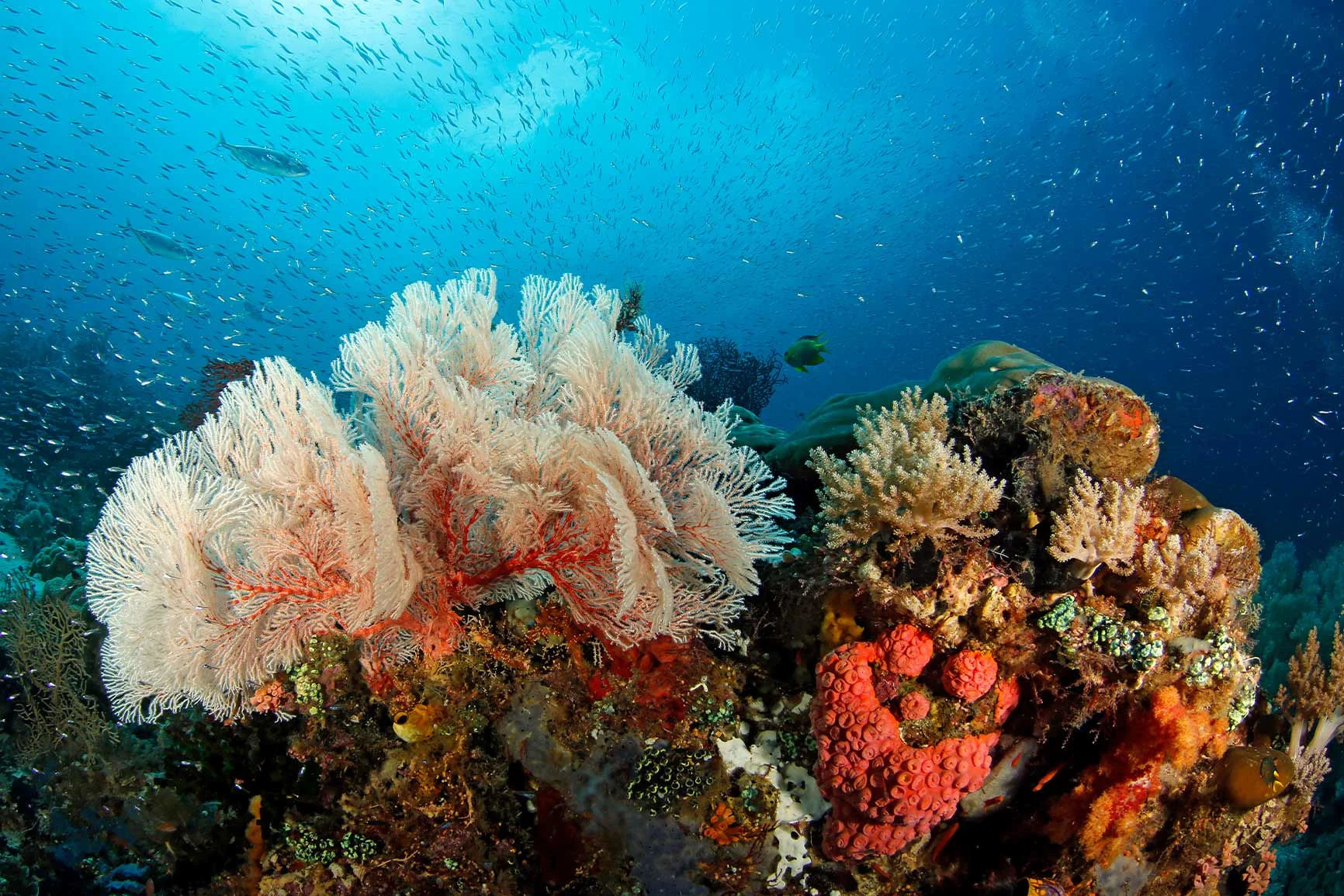
Water absorbs light – red, orange, and yellow tones in particular disappear with increasing depth. This makes it all the more important to photograph as close to the subject as possible. Only short distances allow for vivid colors and sharp details. Natural light sources should be used to their full advantage – for example, when sunlight shines through the water from above.
Tips
Use backlighting for silhouettes and light effects
Photograph with the light, not against it (unless you are deliberately using this as a stylistic device)
Vary the viewing angle for more dynamism
Lighting and perspective

Lighting underwater is different than on land: light is refracted, scattered, and often appears diffuse. Atmospheric images can be created by consciously working with these characteristics—for example, in backlight situations or with cones of light falling through the water's surface. Unusual perspectives, such as looking up at the waterline or using a side camera angle, also enhance the image's impact.
Movement and image stability
Currents, floating particles, and moving sea creatures make photography difficult. Good underwater images are characterized by a calm composition—with a clear focus and as few distracting elements as possible.
Tip:
Use short exposure times for motion stability
Choose simple image compositions with plenty of space
Keep the camera as steady as possible – use two hands or a tripod if necessary
Emotion and closeness
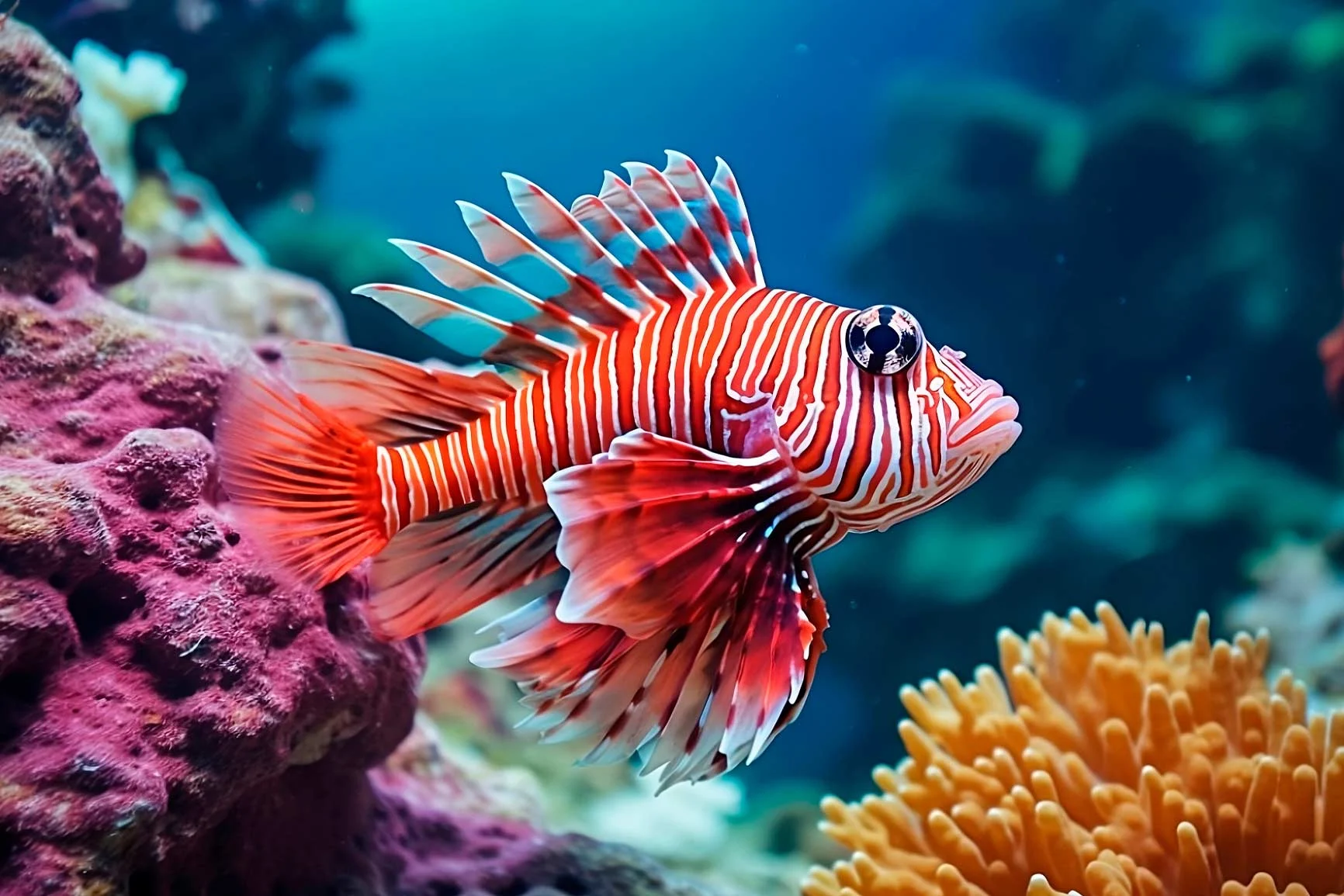
A successful image conveys not only a subject, but also a mood: the curious eye of a fish, the silence between two breaths, or the play of light on a coral block. Proximity, clarity, and tranquility create emotional depth – that's what makes underwater photos so special.
Tip:
Look for emotional subjects, not just visual stimuli
Stay calm and consciously observe your surroundings
Take few, well-considered shots
2. Typical subjects and their special features
The underwater world offers a multitude of fascinating motifs – from colorful schools of fish to minimalist light structures on the sea floor. The decisive factor for impressive images is not only the choice of motif, but also knowledge of its characteristics and how they can be used creatively.
Coral reefs and schools of fish

Colorful coral formations and dense schools of fish are among the most popular underwater subjects – and are also challenging to photograph. The multitude of colors and shapes requires a good eye for composition and clear focus.
Tip:
Choose a clear main subject within the swarm.
Shoot slightly from below to isolate the swarm from the bright water
Look for repetition and patterns as a design element
Snorkelers and divers in action

Travel companions or other divers can be wonderful subjects – as a scale, as silhouettes or interacting with their surroundings. However, moving subjects underwater require good timing.
Tip:
Use backlighting to capture divers as silhouettes.
Pay attention to body posture and air bubbles – they have a strong influence on the effect
Don't position the diver too centrally – movement in the image creates tension
Structures, light effects, and details in shallow water

In shallow water, natural light can be used to create particularly atmospheric images: waves, plants, sand ripples, or light patterns on stones create minimalist and graphically striking shots.
Tip:
Shoot early in the morning or late in the afternoon for soft light.
Pay attention to clear lines and a calm image composition
Make deliberate use of reflections, light cones, or shadows
Seascape portraits
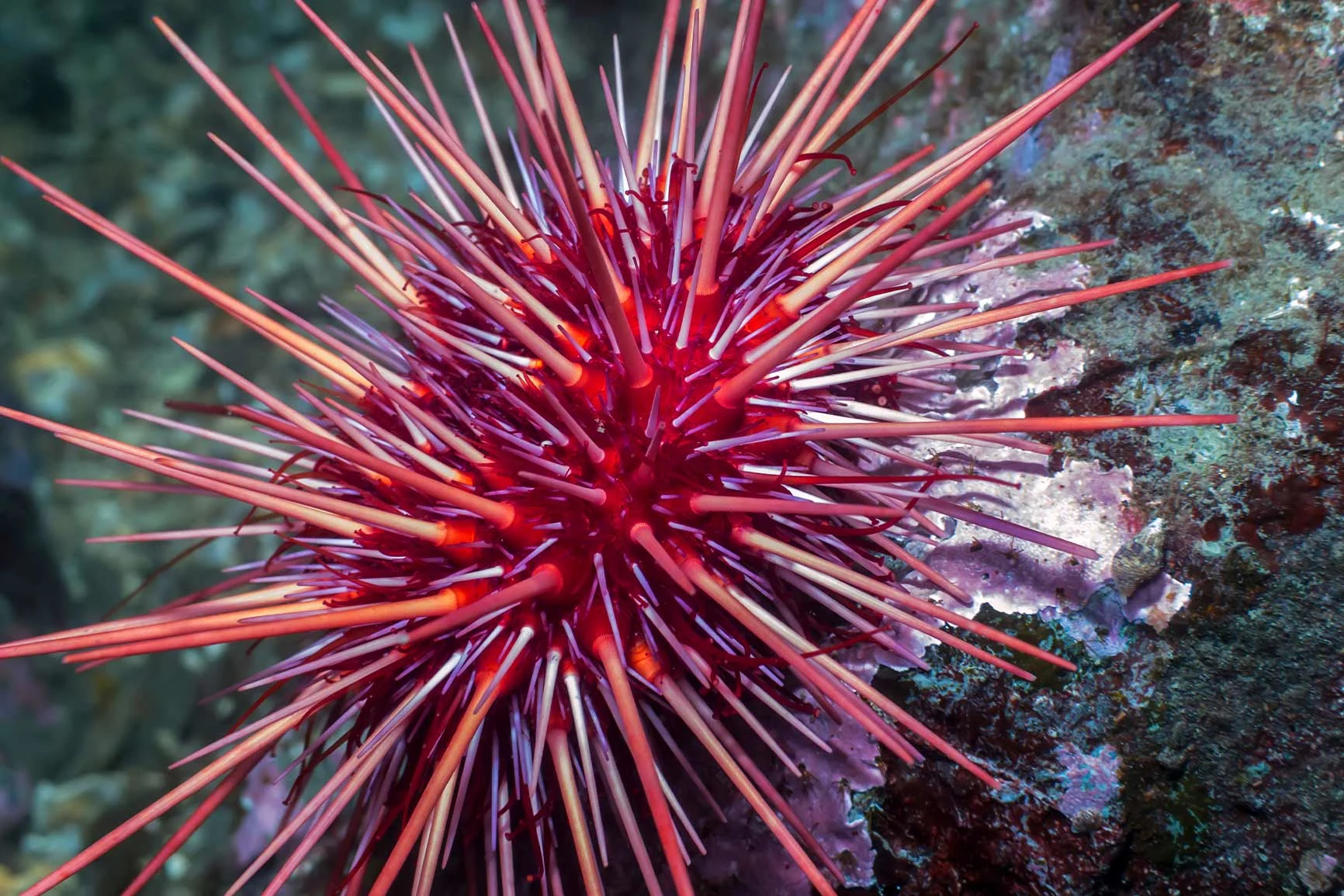
Individual animals – from puffer fish to turtles – are most effective when the image is dominated by proximity and calm. Frantic chasing is off-putting – patience is more important than technique here.
Tip:
Observe instead of rushing – let the animal approach you.
Take photos at eye level if possible
Keep the background simple to draw attention to the animal
Whether wide-angle or detail-oriented, those who know and understand typical underwater motifs can consciously stage them and thus create unique travel images.
3. Technical basics when traveling

Underwater photography requires special equipment – and when traveling, a well-thought-out selection. In addition to weight and space, factors such as humidity, saltwater compatibility, and the duration of dives also play a major role. Those who prepare well will be rewarded with reliable technology and better pictures.
Camera and housing: compact or professional?

Whether you work with a compact camera or a larger system depends on your photographic ambitions, your destination, and the space you have available. In any case, it is important to have a high-quality, waterproof housing with easy-to-use buttons and a good view of the monitor.
Tip:
Compact cameras are ideal for beginners and snorkelers
SLR or system cameras with wide-angle lenses offer more control
Check the housing regularly for leaks and maintain the O-rings
Light and color underwater
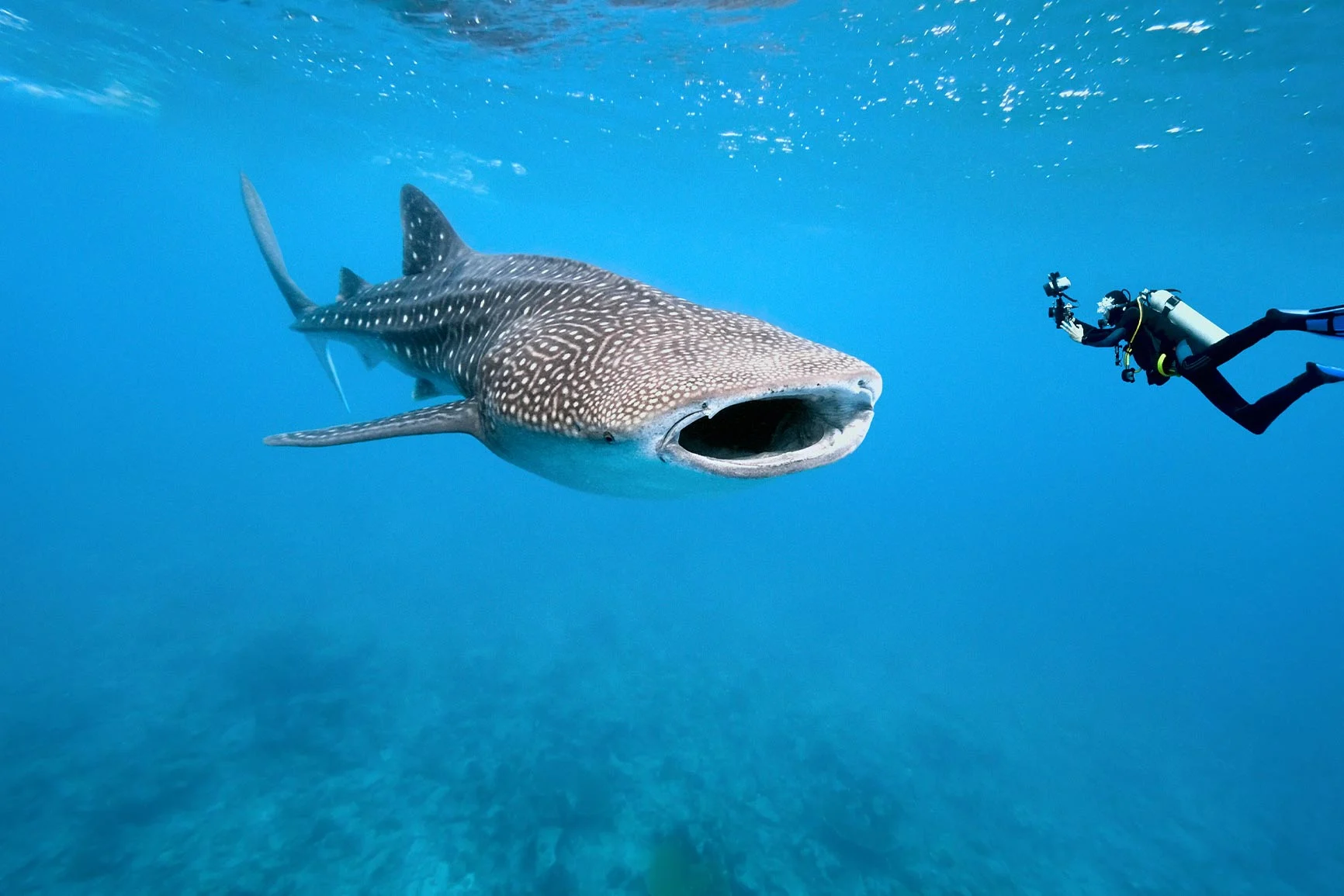
Color intensity and contrast decrease with increasing depth. Without additional light, subjects quickly appear bluish or greenish. Not everyone can transport a large lighting system when traveling – small, mobile underwater flashes or LED video lights are a good compromise.
Tip:
Use red filters in natural light at medium depths.
Make sure there is natural light coming in from above
Small lights help with color stability even at depths of 2–5 m
Transport, protection, and handling on the go
Underwater technology is sensitive. When traveling, you should pack your equipment in shockproof packaging and check it regularly. Waterproof bags, dry towels, silica gel, or simple zip bags help prevent condensation and damage.
Tip:
Use separate transport boxes for the housing and camera
Protect equipment from sun, sand, and salt water when transferring it to a boat
Charge batteries early – power sources are often limited
Battery, memory cards, and backup
Memory and power supply are particularly critical underwater. Before each dive, you need to make sure you have enough power, that all settings are correct, and that you have enough space for new recordings.
Tip:
Use large, fast memory cards with backups
Take extra batteries and chargers with you – especially on longer trips
Test your camera on site and check the settings
With well-designed technology – compact or professional – you will be prepared for every trip to take unique underwater pictures safely and reliably.
4. Image editing and color adjustment
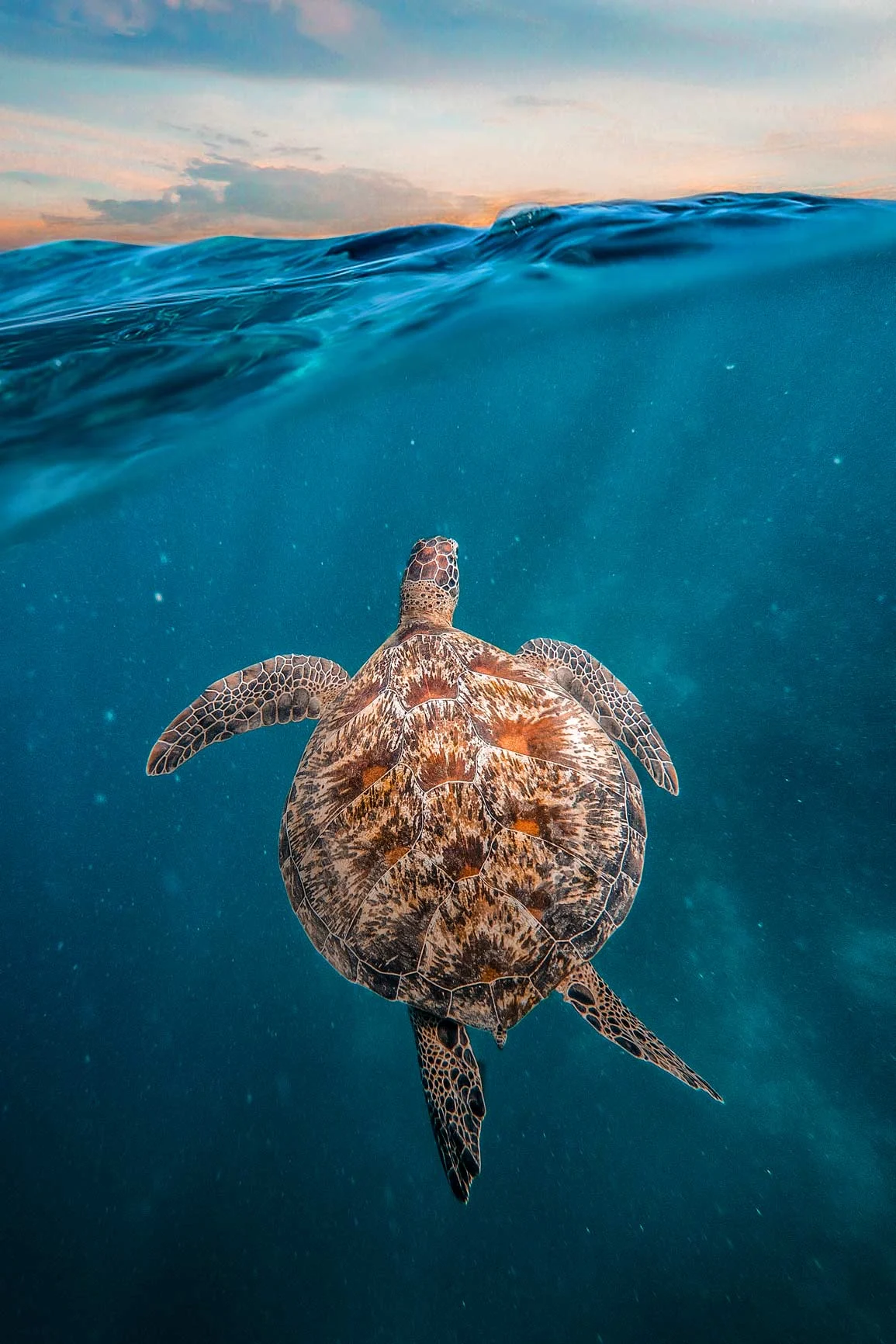
Even the best underwater shots often need a little fine-tuning to reveal their full potential. Water filters colors, reduces contrast, and changes lighting conditions. Targeted post-processing helps you recover lost image information and emphasize your own photographic style, whether natural or artistic.
Correct color casts

Blue and green tones dominate in the depths. Red and yellow often disappear completely. With targeted color correction—especially in the white balance area—you can partially restore these colors.
Tip:
Use manual white balance tools or selective color correction
Selectively enhance red and yellow tones without losing the image balance
Adjust color profiles depending on the depth of light (shallow water vs. deep dive)
Increase contrast and clarity

Underwater images often appear dull – lacking contrast, sharpness, or structure. Local contrast enhancement, clarity controls, and the targeted use of black and white points can help here.
Tip:
Use clarity and haze removal in moderation
Use depth selectively to make structures visible
Ensure even tone distribution in the histogram
Balance sharpness and noise
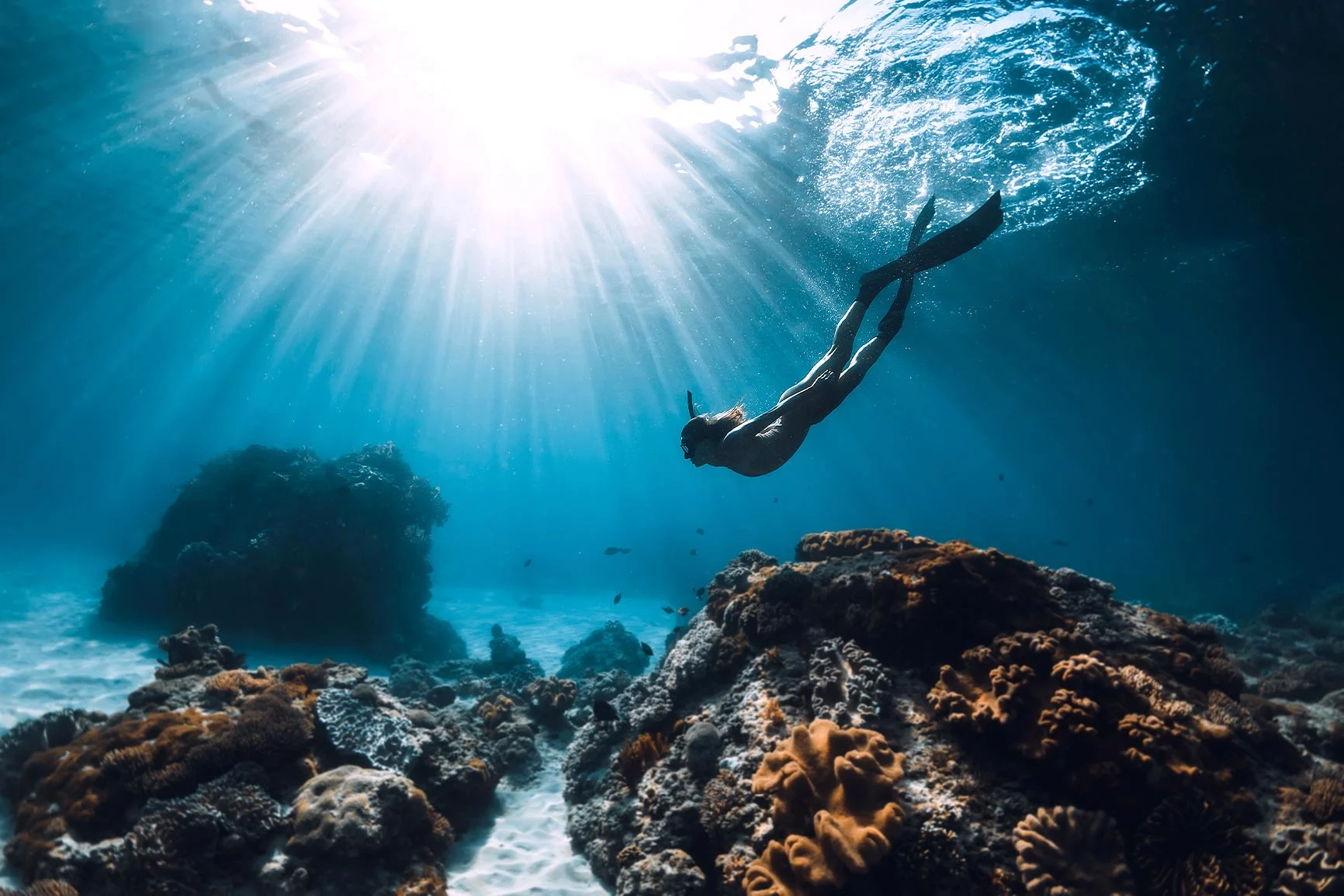
Water movement, lack of light, or high ISO values often cause a slight blurring effect. Subsequent sharpening (localized, not across the entire image!) can help bring out fine details.
Tip:
Don't sharpen too much – underwater images should appear soft.
If there is noise, it is better to remove it and mask specific details.
Focus primarily on eyes, lines, or structures
Artistic processing or natural representation?

The decision as to whether an image should be edited to look realistic or stylized is up to the photographer. Warm colors can have a calming effect, while high contrast can add drama. It is important that the visual language fits the series and the intended presentation.
Tip:
Develop a consistent style, e.g., natural reefs or abstract light images.
Experiment with color looks, but keep the subject in focus
For series, ensure consistent editing for a harmonious effect
With careful editing, you can create underwater images that not only document but also design—and thus unfold their full visual power.
5. Presentation and printing: The underwater world on your wall
Underwater photos don't reveal their full magic on a screen – they need to be on the wall. The visual depth, the play of colors and light, and the special mood of these images demand a presentation that brings them to life. WhiteWall offers high-quality printing options that are precisely tailored to the unique characteristics of underwater photography.
Fine Art pigment print behind acrylic glass
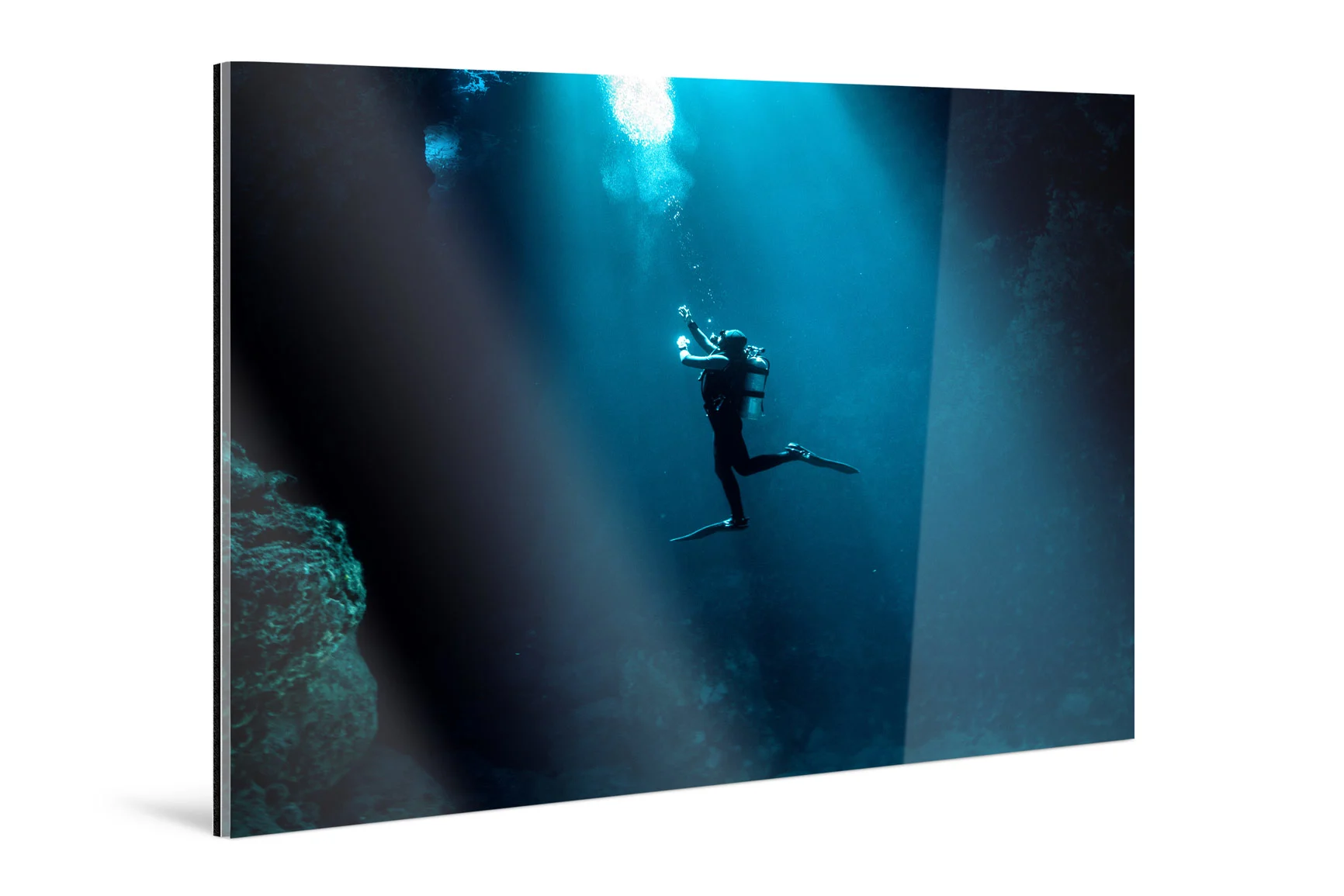
If you are looking for the highest print quality and the finest details, combine Fine Art Print with the depth effect of acrylic glass with Fine Art pigment print behind acrylic glass. This combination offers gallery quality and is particularly suitable for expressive individual photographs with strong image composition.
Tip:
Maximum detail and color brilliance
Perfect for calm shots, portraits, or structured reef shots
High standards of color accuracy and material quality
Aluminum Dibond for modern clarity
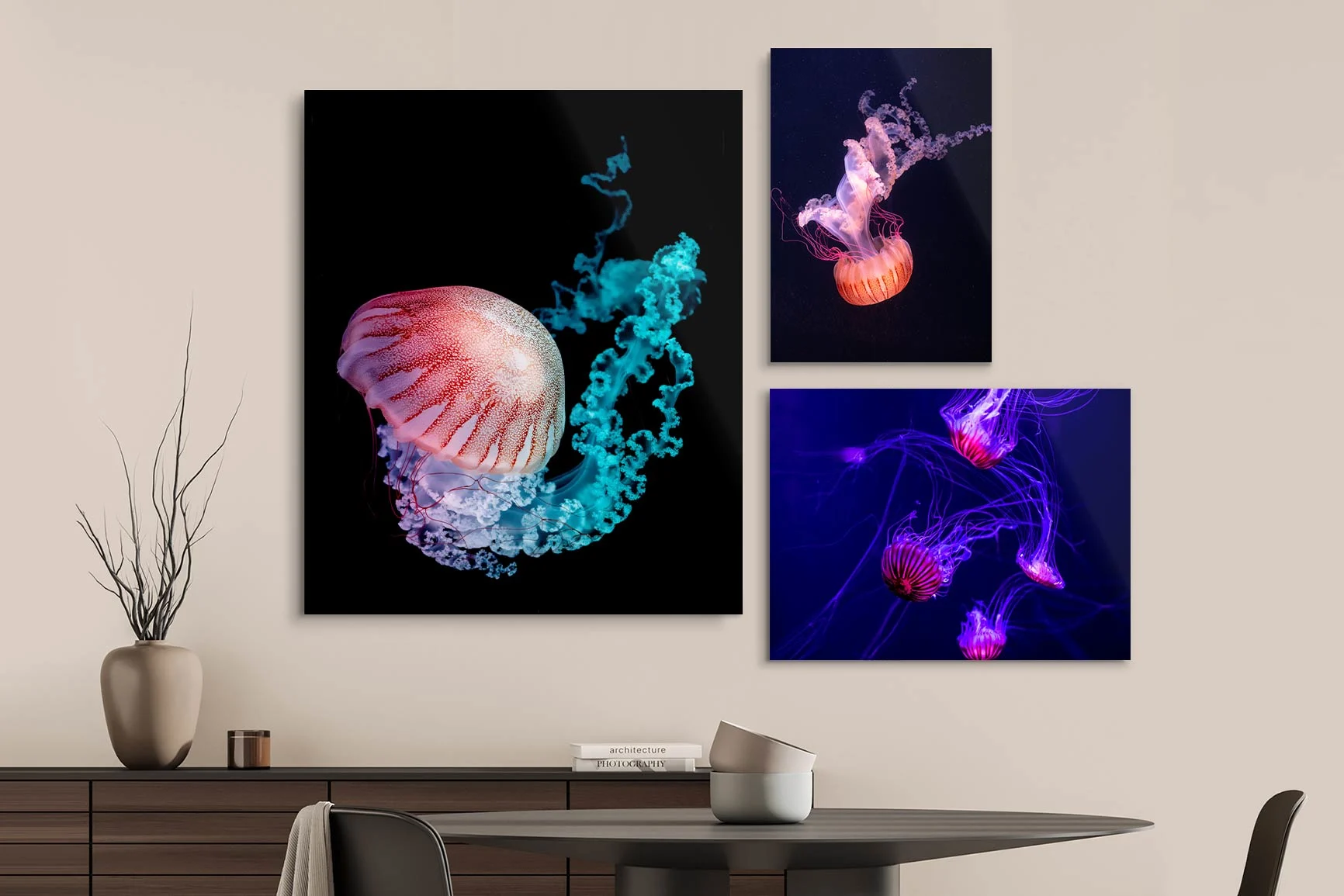
If you prefer something more subtle but still want a high-quality presentation, photo prints on aluminum Dibond offer a reflection-free and particularly clear solution. The matte surface is ideal for rooms with lots of light or difficult angles.
Tip:
Best choice for black-and-white photos or calmer color compositions
Insensitive to reflections
Timelessly modern and lightweight
WhiteWall Minis – Small details in a big way
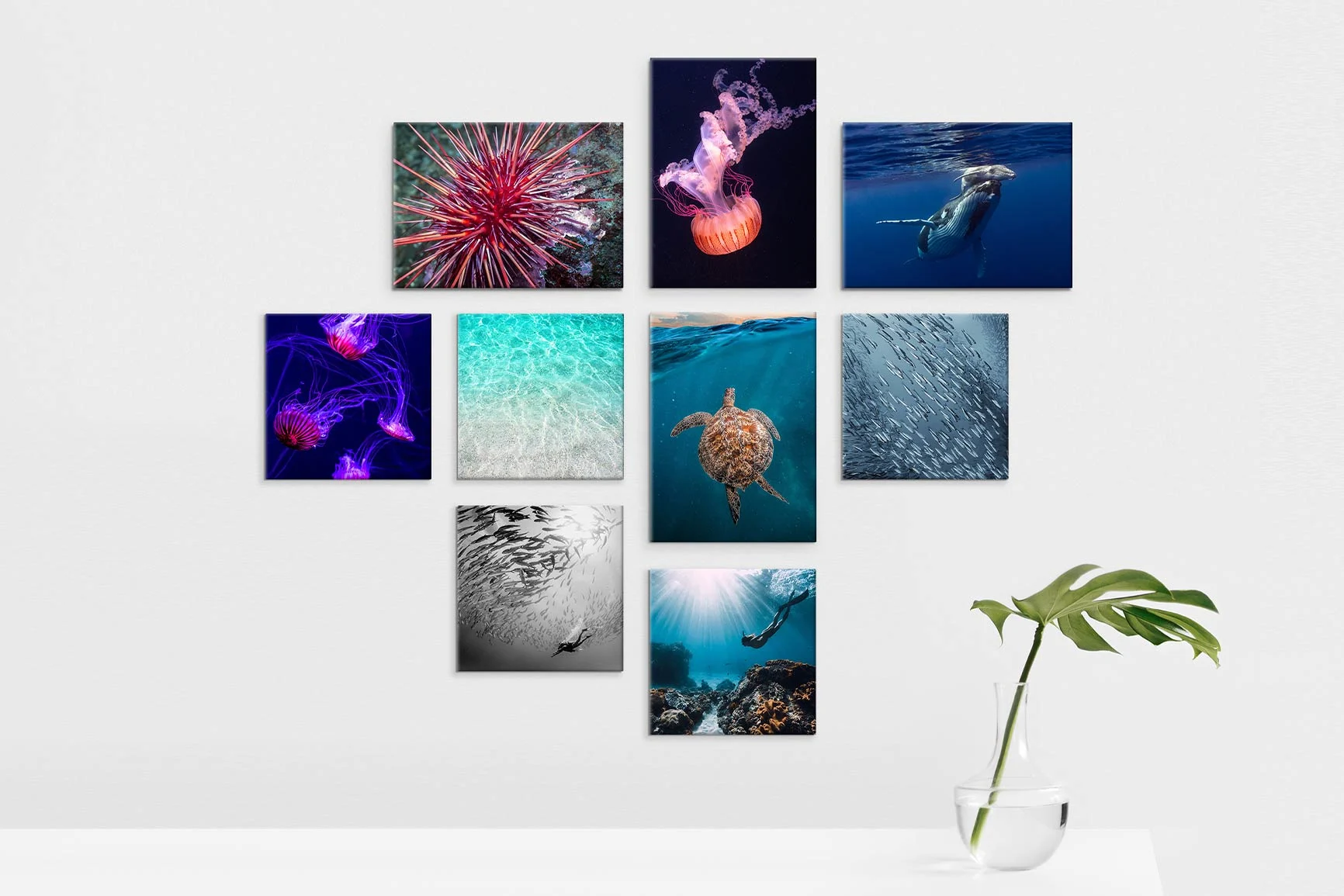
WhiteWall Minis are perfect for showcasing individual image details or sections of larger underwater photos separately – such as structures in the sand, close-ups of coral or light reflections on water surfaces. The smaller format really brings out the best in images taken with action cameras or with limited resolution.
Tip:
Ideal for small walls, galleries, or as a complement to large formats
Adhesive backing – easy to mount without drilling
Perfect for motifs with strong colors or graphic structures
Round formats – for special motifs with an organic character

Some motifs look particularly striking in a round format – e.g., spiral-shaped schools of fish, circular light patterns, or the natural structure of coral. Round formats showcase these motifs in an unusual way and deliberately break with classic hanging formats.
Tip:
Supports the natural shape of structures or movement patterns
Ideal for graphic details and unusual perspectives
Perfect as a single image or as a contrasting element in a picture wall
Conclusion: Underwater photos as special travel memories
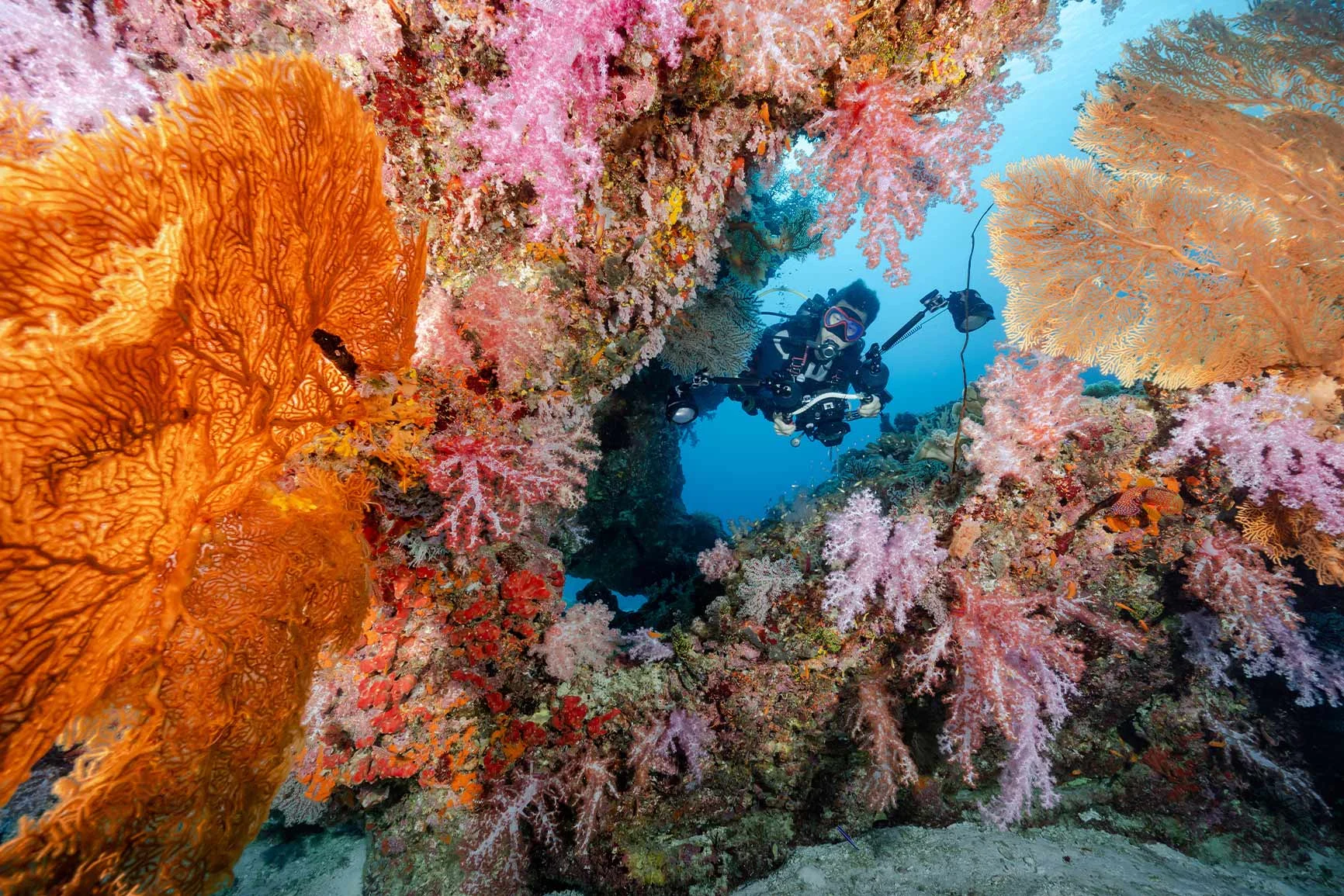
Underwater photography opens up a fascinating world when traveling – full of colors, light effects, structures, and encounters with nature. Capturing these moments not only preserves a memory, but also a visual experience that touches the soul. However, it is only through the right editing and high-quality presentation that underwater photos reveal their full emotional and aesthetic power.
With the right products – from brilliant acrylic glass prints and elegant Fine Art pigment prints to creative solutions such as WhiteWall Minis or round formats – travel photos can be presented in an impressive and individual way. Whether as a large-format eye-catcher or as part of a themed wall, underwater images bring calm, depth, and a touch of magic to any room.
WhiteWall is your reliable partner every step of the way – with gallery quality, precise workmanship, and a wide range of presentation options. Your dives will become more than just moments underwater – they will become lasting works of art on your wall.
Learn more about the author
As a trained portrait and wedding photographer, Katharina Wergen brings her extensive knowledge to photography. She has been working as a sales consultant at WhiteWall since 2018 and supports exhibition projects for museums and galleries. She is also increasingly focusing on reportage photography. Take a look behind the scenes of the photographer, here in the interview.

Also interesting:
Submitted by WhiteWall expert Katharina Wergen
Photo equipment when traveling: Tips and recommendations for photographers
Whether you're looking for a compact camera, versatile lenses, or clever accessories, discover what's important when it comes to photography equipment for on the go. Ideal for anyone who wants to take flexible, creative, and technically well-prepared photos while traveling.
Submitted by WhiteWall expert Katharina Wergen
Material & motif recommendations – How to take impressive travel photos
Learn how to create unforgettable travel photos with careful planning, the right equipment, and creative ideas. Whether nature, city, or culture—this guide offers inspiration and practical tips for impressive motifs and the perfect image presentation.
Submitted by WhiteWall expert Katharina Wergen
Top spots for photographers worldwide
Discover the most beautiful photo spots in Europe – with tips on motifs, lighting, and image composition. Ideal for travel and landscape photography.




